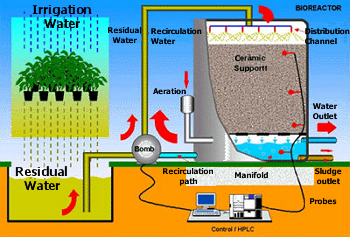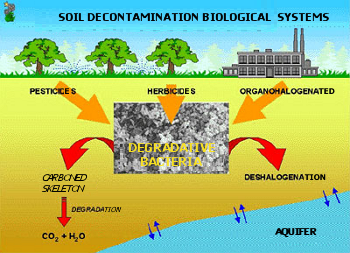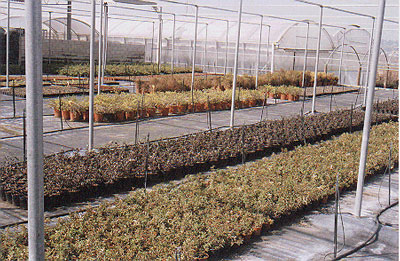BIOLOGICAL SYSTEMS OF DECONTAMINATION OF SOILS AND WATER
|
Description |

Bioreactor for the decontamination of waste water.
Biological systems for the treatment of soil and water contaminated by industrial and agricultural discharges such as herbicides, pesticides and organochlorines.
|
How does it work |
The technique is based on the optimization and/or stimulation of the degradative capacity of autochthonous microorganisms. The immobilization of these strains in ceramic supports increases the biotransformation of toxic and persistent compounds, and facilitates the application of this technology.
The recovery of soils is done by applying these bacteria fixed on different supports in the contaminated area and optimizing the conditions necessary for biodegradation to occur.
The decontamination of water is carried out in a bioreactor in which the biomass is immobilized in a ceramic support contained within a scalable vessel and adaptable to the volume of water to be decontaminated.
The use of adsorbed or covalently bound viable cells on solid supports presents important advantages for the design of industrial bioreactors versus traditional contact systems: higher surface/volume ratio, low pressure drop and greater diffusion of oxygen.

Scheme of the biodegradation of contaminants in soils.
|
Advantages |

Application of technology in the nursery sector, for decontamination and reuse of drainage water.
There are many advantages to using these new technologies compared to conventional ones for physical and chemical treatments.
Technically speaking, the basis of degradation is the immobilized biomass, composed of native and non-pathogenic cells.
No polluting chemicals or large amounts of energy are used for earthworks or aeration.
It can be adapted to the residue concentration levels. The large number of microorganisms that can be available, allows the treatment of different contaminants.
The economic benefits are obvious, to which we must add the environmental advantages, as eliminating waste does not generate other pollutants.
|
Where has it been developed |
The research team has been working for years in the study and application of the degradation capacities of microorganisms. It is a multidisciplinary team made up of biochemists, microbiologists, veterinarians, chemical engineers and agronomists who have made important advances in the degradation of phenolic compounds, acetamides and triazines.
The technology developed by this team is being applied in nurseries, in collaboration with a company of the sector. The results obtained in the recovery of contaminated soils have demonstrated that this technology is an alternative and / or a complement to the traditional techniques. The decontamination and reuse of the irrigation water through the installation of a bioreactor implies a reduction of the pollutant inputs to the environment (eutrophication), in addition to a significant economic saving for the company.
|
And also |
The research team offers the following services:
- Adaptation of the technology most appropriate to each particular case.
- Isolation of autochthonous strains specific to the contaminant to be degraded.
- Development of the technique in pilot plant.
- Scaling and application at real operational level.
- Continuous technical assistance.
|
Contact |
|
© Office for the Transfer of Research Results – UCM |
|
PDF Downloads |
|
Classification |
|
Responsible Researcher |
Margarita Martín Fernández: margamar@vet.ucm.es
Department: Biochemistry and Molecular Biology IV
Faculty: Veterinary Medicine


